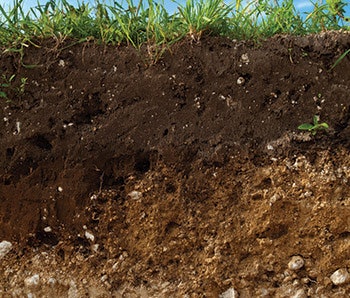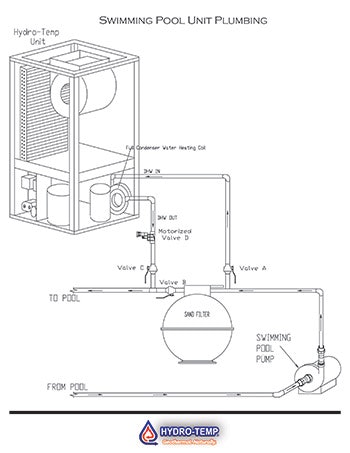

Some people probably find it surprising, or even hard to believe, that you can heat or cool a home using energy that’s stored in a body of water such as a swimming pool or a pond. After all, we’ve been trained to think of putting heat into the water, not taking it out.
It’s true though, because any body of liquid water contains heat energy we can measure and use. In fact, ice contains heat as well, and so does every other substance with a temperature above absolute zero or minus 459 degrees Fahrenheit.
For practical purposes, we’ll stay with liquid water.
I’ll explain how that works just below, but first it’s fair to point out that our industry is largely missing out on a genre of heating concepts and strategies that include not only using a pool to either cool or heat a home, but also geothermal heating, the use of heat pumps and even heat generated from burning wood. Although it’s used to some extent, I’d also argue that solar heating belongs on that list.
The reason for the disconnect, I believe, comes down to a basic lack of familiarity with the technology. Many people may have heard of geothermal heating, for example, but far fewer know how it works and even fewer still know how to apply it.
THE BATTERY ANALOGY
When we talk about using a pool as a heat source, it’s helpful to think of it as a battery. Instead of containing energy in the form of electricity, the energy in a pool is in the form of heat that we can measure in Btus (British thermal units).
In practical terms, the heat energy from pools can be used until you drop the temperature of the water to a few degrees above freezing because if you turn the water into a giant block of ice, it will damage the pool. In that case, you’d have to “recharge” the battery by adding Btus back to the pool with fossil fuel heating, solar, geothermal heat or from a furnace that burns wood.
The first hurdle is to understand that what we perceive as hot and cold is irrelevant when it comes to seeing water as a source of heat. In other words, although 55-degree water feels quite cold to the touch, it still contains heat. The amount of heat depends on the temperature of the water and the volume of water available.
Now let’s take the battery analogy another step further. Both the earth and the sun can be viewed as batteries so large they can, for any practical purpose, be viewed as containing an infinite amount of free and useful heat energy. We know how solar works, but far fewer of us are familiar with how we extract heat from water or the ground.
Before we get into geothermal heating, however, let’s talk a little bit more about using a swimming pool to raise the air temperature in a home.
HOME HEATING

To start, first remember that heat always flows from hot to cold.
Using that fundamental principle of physics, you circulate water through a coil of pipe that is in contact with the body of water. The heat present in the body of water is transferred to the water in the pipe, and then extracted from the water in the pipe for use in the home using a heat pump.
After circulating back to the pool, the water flowing through the pipe is colder than the pool water because it’s had heat extracted from it. That means no matter the temperature of the pool, assuming its above freezing, the water flowing through the pipe will be a lower temperature and able to absorb heat. Because heat flows from warm to cold, even if the water in your pool is 45 degrees, the water in the pipe will be 40 degrees or 35 degrees and will be able to absorb heat from the warmer water.
You can also circulate water straight from the pool and extract heat directly from it without using the pipe. Either way, the principle remains the same.
Geothermal heating works in a similar manner, except instead of drawing heat from a swimming pool, the water in the coil absorbs heat from the ground.
The heart of this type of system is the heat pump. The heat pumps familiar to the pool industry are those that absorb heat from the air and transfer it to water in a pool. In the case of heating a home with a swimming pool, however, we’re talking about heat pumps that take heat from water and transfer it to the refrigerant, a process appropriately known as water-to-water heat exchange. These systems are widely known as water-source heat pumps, or WSHPs.
In this type of system, loop water is circulated through a heat exchanger, where the water in the loop that has extracted heat from the pool water in turn transfers heat to water flowing the through a second loop inside the heat pump.
The second heat exchanger in the heat pump is where the Btus from the heated water are transferred to a coil that contains refrigerant. The refrigerant absorbs the heat, which is then used in an evaporative heating coil located inside an air handler located inside the home.
The beauty of heat pump technology is that you can reverse the system using a simple reverse flow valve, where heat from the refrigerant is transferred to water. That’s how you can take heat from inside the house and heat a swimming pool or spa, or release that heat into the air or ground, while cooling the home.
What all this ultimately means is that you can either heat a home in the winter using pool water, in which case you’re lowering the temperature of the pool water. Or you can cool a home in the summer, in which case you can raise the temperature of the pool water.
FROM THE GROUND UP
Those of us in the pool industry are familiar with three types of heat sources — fossil fuel, electricity and solar. Of those, solar is the only free source of Btus, the other two you have to buy. Although I’m a big fan of solar heating and applaud those builders who use it, solar heating does come with limitations. The sun has to be shining and the solar arrays require a southern exposure.
Geothermal heating offers a very similar profile to solar energy, meaning after an initial investment, the Btus are free; like with sun, the energy in the earth is constant. It can be used as a stand-alone heating system, but in many situations it also makes sense as an adjunct heat source for pools and spas or in a home.
Unlike, solar, however, a relatively small group of builders are familiar with it and even fewer have made the effort to adapt the technology to their consumer offerings. Based on my experience, the status quo needs to change.
One of the prevailing misconceptions about geothermal heat is that it’s regional. While it’s true that the method of application can vary with the climate, to my knowledge there’s no geographical limitation to its use.
Applying geothermal heat in a cost-effective way depends on a number of factors including the body of water’s heating needs, consumer expectations and, of course, budget. Like solar, thermal-heat systems require an upfront investment that can vary significantly depending on those all-important variables. Once installed, however, the return on investment is just a matter of time.
EARTH COUPLING
There are two basic versions of geothermal systems: open loop (about 1 percent of the installations) and closed loop (99 percent of all installations). An open-loop system taps into well water that is circulated through a WSHP. A closed-loop system uses water or a mixture of water and propylene glycol (anti-freeze) circulated through a loop consisting of flexible polyethylene pipe that absorbs Btus from the ground. Either way, you’re accessing heat that is constantly available beneath the earth’s surface.
The earth gains its heat in two ways: from the sun, whose warmth penetrates only a few feet down, or from the earth’s molten core, where the temperature remains relatively constant. In areas with warm surface temperatures, you can use a geothermal system without having to drill holes into the ground and instead run the system’s loops in a shallow trench.
In other cases, such as in regions with freeze-thaw conditions, it’s necessary to drill into the earth to a depth greater than about 30 feet. Once you get below that depth, the temperature of the ground is going to remain constant, generally from 50 to 60 degrees Fahrenheit. In Tennessee where I live and work, the ground temperature stays right around 57 degrees.
As an aside, this is exactly why wine makers favor aging wine in caves; the temperature is constant regardless of the air temperature outside.
As discussed above, even though the ground might feel cold to the touch, there are still lots of Btus available. The system of loops you use to access that energy is referred to as an “earth coupling.” The size and depth of the earth coupling is dependent on the heating demand (Btus required to heat or maintain pool or spa water). The amount of water you want to heat and the desired heat rise determines the cost.
The lifespan of the earth coupling depends on the service life of polyethylene pipe, which conservatively means it will last at least 50 years and probably more.
Of course, this discussion is all general in nature. For more information about geothermal heat, I recommend visiting the Department of Energy website (www.energy.gov).
APPLICATION SCENARIOS
In preparing this discussion, I identified three real-world scenarios you might encounter:
First, the best circumstance for design and installation of a geothermal system or a system that uses pool water to heat or cool a home is new construction or an extensive home remodel. It’s just common sense; the contractor is already there drilling holes for an open-loop or closed-loop system. Also, you’ll have an HVAC company already involved in the project.
Second, if you’re using geothermal energy to heat a pool only, year-round applications make the most sense as opposed to seasonal ones. Geothermal heat is great for maintaining a comfortable temperature, but is slow in delivering heat on demand.
Thirdly, geothermal is wonderful as a supplemental heating system. In this case, you’re using the geothermal system to maintain a baseline temperature and then using heat from another source as needed. As an example, if you’re using the geothermal system to maintain a constant temperature of 85 degrees, but you want to heat an attached spa to 104 degrees, the spa heater doesn’t have to generate nearly the Btus as it would when heating the water from 70 degrees or colder.
Again, it’s all just common sense.
Comments or thoughts on this article? Please e-mail [email protected].











































